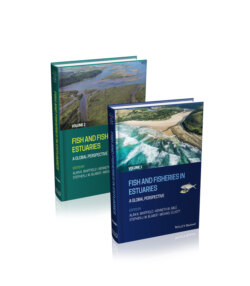Читать книгу Fish and Fisheries in Estuaries - Группа авторов - Страница 68
3.4.1.2 Maternal effects
ОглавлениеVariability in age structure, growth and condition of adults contributes to variability in reproductive output and potentially to success of recruitment of estuary‐dependent fishes. Quantity and quality of eggs and sperm may depend on the condition, size and age of adults. As such, the quality and potential of eggs and larvae to survive depend on maternal (or paternal) investments. In a review of marine fishes, maternal effects were documented for many taxa (Marshall 2016). However, Ottersen et al. (2013) analysed recruitment success of 38 stocks of marine fishes, including some estuary‐dependent or ‐associated stocks (e.g. the Baltic Sea clupeid Clupea harengus membras, Baltic Sea gadid Gadus morhua and European pleuronectid Pleuronectes platessa) and found little evidence of a significant effect of maternal age on recruitment success in those stocks although the authors acknowledged that their data were sparse and difficult to interpret. In a meta‐analysis of effects of maternal age and size on marine fish stocks and implications for recruitment, Venturelli et al. (2009) reported that populations represented by older, larger individuals have a higher maximum reproductive rate than populations of equivalent size represented by younger, smaller individuals, concluding that expanded age structure is important for sustainability in many exploited fish stocks. The relationship between female size and egg number for Pacific salmons can vary with latitude (Fleming and Gross 1990). In the salmonid Salmo trutta, the anadromous traits displayed in some females provide an adaptive advantage and greater fitness during early ontogeny (Goodwin et al. 2016).
Based on laboratory harvesting experiments conducted on the short‐lived, estuarine atherinid Menidia menidia, Conover & Munch (2002) and Conover & Baumann (2009) found strong inferential evidence suggesting that under heavy, age‐ or size‐selective exploitation, a population's reproductive potential could evolve rapidly. For M. menidia experiencing age‐ or size‐selective harvesting of larger, faster‐growing individuals, progeny matured at younger ages and smaller sizes than in unexploited populations. There had been a genetic shift towards production of slower‐growing, earlier‐maturing M. menidia in only four generations. Size‐selective fishing is common in coastal and estuarine fisheries, and it is probable that heavily exploited species in estuaries are more prone to selective harvesting than offshore species. For example, size‐selective fishing has been shown to favour fast‐growing individuals that mature at smaller sizes and younger ages in the anadromous osmerid Osmerus eperlanus from the Gulf of Riga, Baltic Sea (Arula et al. 2017) and Osmerus mordax in the northeastern USA (Chase et al. 2019).
The pleuronectid Pleuronectes platessa has experienced declines in size at maturity and shifts in growth rate and age structure in the southern North Sea in the past century that are attributed to changing fishing mortality rates. Rijnsdorp (1993) inferred that these changes were in part genetic, but not independent of concurrent changes in productivity of juvenile coastal and estuarine habitats. He also found that, while growth dynamics changed, the reproductive investment by females did not (i.e. relative ovary weights of females remained constant), although there was a shift in recent decades towards larger but fewer eggs in ovaries (Rijnsdorp 1993). In laboratory experiments on P. platessa, Kennedy et al. (2007) concluded that larger females produce bigger eggs and larvae with greater yolk volumes that grew faster than larvae from eggs of smaller females. Maternal effects on spawning also were demonstrated in laboratory experiments on the estuarine pleuronectid Pseudopleuronectes americanus (Buckley et al. 1991). In a protracted spawning season, large, early‐spawning females produced bigger eggs than those produced by small, late‐spawning females, implying that conservation of large females in P. americanus will maintain large egg sizes, overall fecundity and presumably increased survival potential of early‐life stages. Overall, there is compelling evidence that selective forces (primarily fishing) can modify age structure and precipitate changes in reproductive and recruitment potential of estuary‐dependent fishes such as P. platessa and P. americanus.
In the anadromous moronid Morone saxatilis from the east coast of North America, effects of changes in age structure of the adult stock and its effects on reproductive success and recruitment potential are well documented (Secor 2000). Overfishing led to stock depletion, a severe reduction in abundance of mature, older age classes and recruitment failures (Richards & Rago 1999). Secor (2000) demonstrated that recovery and conservation of older age classes promoted diversity in the timing of spawning amongst age classes in Chesapeake Bay, which was important for sustained reproductive success. Older and larger females produce larger eggs and larvae (Zastrow et al. 1989). In laboratory experiments, larger larvae maintained their size advantage from hatching throughout a 25‐day experimental period (Monteleone & Houde 1990), conferring a potential survival advantage and arguing in support of Secor's (2000) recommendation to conserve age diversity of spawning adults.
In anadromous Pacific salmonids, heavy exploitation over decades of selective fishing on larger and faster‐growing individuals has affected sizes and age structure of spawners such that adults are smaller now than historically (Ricker 1981). The reduction in spawner size was especially notable for Oncorhynchus tshawytscha whose body weights declined to less than 80% of historical weights. The effect was also substantial in O. kisutch, O. gorbuscha and O. keta (Ricker 1981). The implications are that reduced fecundities, smaller egg sizes and reduced egg quality can lower fitness and recruitment potential. Recently, the decline in spawner weights of Pacific salmonids has stabilised for O. gorbuscha and O. keta and reversed in O. tshawytscha and O. kisutch (Jeffrey et al. 2017), indicating that recovery of spawning potential from effects of excessive exploitation is possible through appropriate management.
